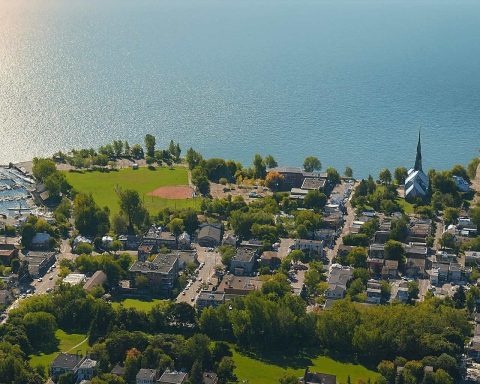Published November 25, 2025
As the U.S. and Canada head into the heart of the 2025–26 winter season, a familiar pattern is emerging on the roads: construction zones are shrinking just as travel volumes and winter storms ramp up.
From Indianapolis to the Canadian prairies and the mountain passes of New Mexico and Montana, transportation officials and local businesses are racing the weather—and the calendar—to keep people moving safely in one of the busiest travel weeks of the year. [1]
Fewer Orange Cones, More Drivers: Indiana Eases Lane Closures for the Holidays
In Indianapolis, the seasonal pivot from construction to winter maintenance is in full swing.
A new report from WRTV explains that while some construction continues, much of the heavy paving and lane-closing work has been wrapped up or paused as temperatures fall across Indiana. [2]
Why winter slows major road work
According to the Indiana Department of Transportation (INDOT), many projects simply aren’t compatible with freezing air and cold pavement:
- Hot asphalt can’t be produced or placed effectively in winter. It doesn’t bind properly in low temperatures, which makes new pavement or permanent repairs unreliable. [3]
- Key work like paving, striping and many concrete operations are limited or stopped, because they depend on hot materials and dry surfaces. [4]
- Crews shift to cold-asphalt pothole patches and shorter-term fixes—good enough to get drivers through the season, but not a long-term solution.
INDOT officials say they deliberately load most of the intense work into spring, summer and early fall, then focus on traffic management and safety through the colder months. That planning means more lanes reopen just in time for Thanksgiving week, when traffic on interstates like I‑65 spikes.
One official noted that drivers should expect “less work, different types of work, and not as many lane closures when we move into the winter,” which is welcome news for Hoosiers and cross-country travelers alike. [5]
Good timing for record Thanksgiving traffic
That reprieve aligns with a holiday travel surge. AAA projects 81.8 million Americans will travel at least 50 miles from home over the Thanksgiving period this year—an all‑time record. [6]
Even with fewer active work zones, more drivers plus early-season storms mean:
- Heavier congestion on key corridors, especially around major metros.
- Short-term delays from minor winter maintenance, plow activity, and bridge work that can continue in colder conditions.
- Higher stakes for any crash or closure, as alternative routes may be limited by the remaining construction or weather-related restrictions.
For drivers passing through Indiana, the big takeaway this week: expect fewer cones and detours than in summer, but don’t assume construction has disappeared. Some long-term projects still span multiple seasons, and winter storms can quickly erase any time gained from reopened lanes. [7]
New Mexico’s “Cone Zone” Winds Down—but Not Completely
Farther west, Los Alamos County in New Mexico is also pivoting into winter mode.
A recent “Cone Zone” update from the Los Alamos Daily Post notes that most county construction projects have wrapped up for the winter, but a handful of significant closures remain in place. [8]
Key impacts around Los Alamos
According to county information shared via the update: [9]
- Construction has generally slowed for the season, but a few work zones stay active into December.
- The Jemez Mountain Fire Protection Project is keeping Camp May Road closed Monday through Friday, shutting off vehicle access and nearby trailheads during the workweek.
- Additional utility and road repair work is pending at several locations—including Aztec Ave., Grand Canyon Drive, Trinity Drive near Motel 6, West Road and 33rd Street—where crews still need to restore pavement or adjust infrastructure once conditions allow.
Officials emphasize that essential services continue—mail, trash and recycling, and emergency response—but residents and businesses may still experience noise, heavy equipment and minor travel delays near remaining sites. Drivers and pedestrians are urged to slow down and follow detours carefully. [10]
In short: Los Alamos is mostly done with its big 2025 road projects, but visitors heading to ski areas or the Jemez Mountains still need to watch for weekday closures and lingering work zones.
Regina Braces for a Colder‑Than‑Usual Prairie Winter
North of the border, Regina, Saskatchewan, is preparing for a winter that looks both colder and more disruptive than average.
A new analysis on Meyka highlights forecasts from Environment Canada suggesting prolonged stretches of below‑normal temperatures across the prairies, including Regina. [11]
Economic ripple effects for local businesses
The colder outlook is already raising concerns among local retailers and restaurants:
- Reduced foot traffic: When temperatures plunge and snow piles up, people are less likely to browse shops or dine out, especially in walkable downtown areas.
- Supply-chain hiccups: Snowy roads and icy highways can slow freight, delay deliveries, and complicate restocking schedules.
- Higher operating costs: Heating bills climb while customer counts dip, squeezing margins for small businesses.
The Meyka piece notes that businesses relying on walk‑in customers—such as independent retailers, cafés and service providers—are particularly exposed. Many are looking at contingency planning, stronger online sales, and tighter inventory management to ride out the season. [12]
Travel and weather outlook in Regina
On the travel side, the same colder, stormier pattern raises the risk of:
- Flight delays and cancellations, particularly during major systems moving across Alberta and Saskatchewan.
- Bus and highway disruptions, including temporary closures or reduced speeds on icy highways.
- Higher accident risk on city streets when freeze–thaw cycles create black ice.
Recent regional coverage has already warned of snowy commutes and potential travel delays for drivers in Alberta and Saskatchewan, including Regina, as early-season systems move through. [13]
However, as of early Tuesday, November 25, federal weather alerts show no active warnings in effect for the City of Regina, underscoring how quickly conditions can shift from “normal” to hazardous in the prairies. [14]
Stormy Setup: La Niña Winter Favors More Snowy Travel Days
This week’s travel challenges aren’t happening in a vacuum—they’re part of a broader La Niña‑influenced winter pattern.
NOAA’s Climate Prediction Center and the National Weather Service expect a weak but persistent La Niña through the 2025–26 winter, with: [15]
- Cooler‑than‑average temperatures favored from the Upper Mississippi Valley and northern Great Plains west toward parts of the Pacific Northwest.
- Wetter‑than‑average conditions favored from the northern Rockies and northern Great Plains into the Great Lakes and Ohio Valley—regions that are heavily travelled during the holidays.
- More variability in snow and cold spells, meaning periodic bursts of intense winter weather rather than steady, uniform conditions.
Those broad trends are already showing up in the forecast and on the ground.
Heavy snow threatens key Thanksgiving travel routes
Multiple outlets report that a major Thanksgiving‑week winter storm is set to sweep across the Northern Plains, Upper Midwest and Great Lakes, with the potential for 1 to 3 feet of lake-effect snow in areas downwind of Lake Superior and widespread totals of 4–8 inches elsewhere. [16]
The National Weather Service has warned that the combination of heavy snow and high winds could produce:
- Whiteout conditions and snowdrifts
- Slick, icy roads
- Dangerous visibility drops during peak travel hours
These impacts could stretch from North Dakota and Minnesota into Wisconsin and Michigan, right along some of the busiest interstate corridors in the country—including highways feeding Chicago and other Midwestern hubs. [17]
In the Mountain West, NBC Montana’s forecast calls for light to moderate snow and slick travel early this week, with 2–5 inches expected over key passes like Lookout, Lolo and Lost Trail as snow spreads east into Wednesday. [18]
Taken together, the pattern is clear: even as construction zones shrink, weather risks are expanding across many of the same routes.
Winter 2025 Travel Demand Is Surging Anyway
Despite storm threats and colder outlooks, travelers show little sign of staying home.
- AAA’s holiday forecast anticipates 81.8 million Thanksgiving travelers, up 1.6 million from last year and the highest on record. [19]
- A newly released Tripadvisor Winter Travel Index reports that 60% of surveyed travelers are planning a winter trip, with winter bookings up about 45% year over year as people seek both city escapes and warm‑weather getaways. [20]
Some states are taking extra steps to keep people informed. For example, the South Dakota Department of Transportation is steering drivers to a dedicated Winter Weather Hub and 511 tools to track storms, plow operations and road closures in real time. [21]
In California, transportation officials have issued safety alerts to millions of drivers ahead of the busy travel period, highlighting chain requirements in mountain passes, the risk of rapid storm development and the importance of checking conditions before heading into higher elevations. [22]
The message across jurisdictions is similar: this winter will be busy and, at times, hazardous—but many disruptions are predictable and manageable if travelers plan ahead.
What This Means for Drivers, Commuters and Local Businesses
Whether you’re crossing Indiana on I‑65, navigating Regina side streets, or heading into the mountains near Los Alamos, a few themes stand out for late November 2025:
1. Fewer cones doesn’t mean fewer risks
- Many large paving and reconstruction projects are paused, but long-term projects and utility work continue, sometimes right next to open lanes. [23]
- Temporary winter fixes (like cold asphalt patches) can deteriorate quickly, leading to potholes and uneven surfaces in high‑traffic areas.
What to do: Treat every remaining work zone as a high‑risk area—slow down, avoid sudden lane changes, and watch for workers and narrowed shoulders.
2. Weather is now the main driver of disruption
- Early-season storms in the Northern Plains, Great Lakes and northern Rockies are expected to cause intermittent closures and delays on major interstates.
- Local roads in places like Regina can shift from bare to icy in hours when cold fronts and snow bands move through. [24]
What to do:
Check forecasts along your entire route, not just your departure city. For U.S. travel, that means monitoring regional NWS offices and state DOT sites; in Canada, check Environment Canada and local 511-style services.
3. Local economies are adapting—but feeling the strain
- In Regina, businesses are bracing for lower walk‑in traffic and higher logistics costs, layering winter challenges on top of broader economic pressures. [25]
- In tourist‑oriented areas around New Mexico and Montana, strong winter recreation seasons can be a boon—but only if roads remain safely passable and closures are clearly communicated. [26]
What businesses can do:
- Strengthen online ordering, delivery and curbside pickup options for bad-weather days.
- Coordinate closely with suppliers on alternate routes and timing.
- Communicate clearly with customers about hours, delays and safety measures.
4. Personal preparation matters more than ever
Given the combination of:
- Record travel volumes
- A La Niña‑tilted winter pattern
- Ongoing—but reduced—road work
…travelers should assume that somewhere along their route, there will be a choke point.
Smart moves include:
- Packing an emergency kit (warm clothing, food, water, power bank, ice scraper).
- Keeping the fuel tank at least half full in storm‑prone areas.
- Allowing extra time for mountain passes, lake‑effect snow belts, and any active work zones.
- Using official apps—state 511 systems, airport apps, airline SMS alerts—to track conditions in real time.
Regional Snapshot: Today’s Big Takeaways (November 25, 2025)
- Indiana / Midwest:
Most major road projects have wound down for the season, easing lane closures just as Thanksgiving traffic peaks—but icy conditions and residual work zones still demand caution. [27] - Los Alamos County, New Mexico:
Construction activity has largely slowed, but important projects like the Jemez Mountain Fire Protection work keep some roads closed on weekdays. Check local updates before heading into canyon or mountain areas. [28] - Regina, Saskatchewan:
Forecasts point toward a colder‑than‑normal winter with potential for travel and supply-chain disruptions, even though no formal weather alerts were in effect this morning. Local businesses are adjusting operations for a tougher season. [29] - Nationally (U.S.):
A weak La Niña is stacking the deck for colder, snowier spells in the northern U.S., just as record numbers of people hit the road and sky for the holidays. Multiple storms this week could snarl travel in the Northern Plains, Upper Midwest and Great Lakes. [30]
For now, the best strategy is simple: treat winter like an active construction zone—slow down, stay informed, and expect conditions to change quickly.
References
1. www.wrtv.com, 2. www.wrtv.com, 3. www.wrtv.com, 4. www.wrtv.com, 5. www.wrtv.com, 6. newsroom.aaa.com, 7. www.wrtv.com, 8. ladailypost.com, 9. ladailypost.com, 10. ladailypost.com, 11. meyka.com, 12. meyka.com, 13. ca.news.yahoo.com, 14. weather.gc.ca, 15. www.weather.gov, 16. www.newsweek.com, 17. www.newsweek.com, 18. nbcmontana.com, 19. newsroom.aaa.com, 20. www.prnewswire.com, 21. dot.sd.gov, 22. www.newsweek.com, 23. www.wrtv.com, 24. meyka.com, 25. meyka.com, 26. nbcmontana.com, 27. www.wrtv.com, 28. ladailypost.com, 29. meyka.com, 30. www.weather.gov










